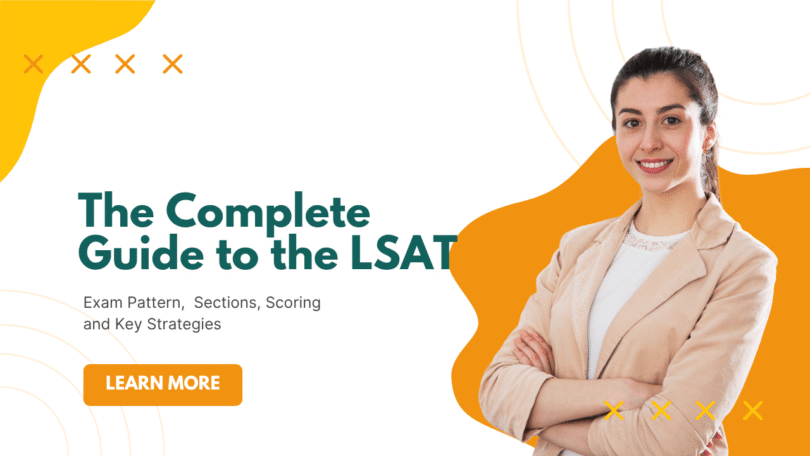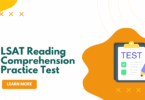The Law School Admission Test (LSAT) is the standardized test required for admission to nearly all law schools in the United States, Canada, and Australia. Unlike most academic exams, the LSAT does not test knowledge of law or history; instead, it is a skills-based examination designed to measure aptitude for success in the demanding first year of law school. Specifically, it assesses skills in critical thinking, logical reasoning, and reading comprehension.
Understanding the LSAT’s structure, question types, and scoring is the foundational first step in any effective preparation plan.
LSAT Exam Pattern and Structure (Post-August 2024)
The LSAT is administered in two parts: a multiple-choice component and a separate, unscored writing sample.
The multiple-choice portion consists of four 35-minute sections and takes approximately 2 hours and 20 minutes to complete (excluding breaks).
| Section Name | Number of Scored Sections | Approximate Questions per Section | Time Allotment | Function |
| Logical Reasoning (LR) | Two (Scored) | 24 – 26 | 35 minutes each | Measures the ability to analyze and evaluate arguments. |
| Reading Comprehension (RC) | One (Scored) | 26 – 28 | 35 minutes | Measures the ability to read, understand, and draw inferences from dense, scholarly text. |
| Variable Section | One (Unscored/Experimental) | 24 – 28 | 35 minutes | Used by the LSAC to test new questions. Can be either an LR or RC section. Does not count toward your score. |
| LSAT Writing | One (Unscored) | 1 essay response | 50 minutes (administered separately) | Tests persuasive writing skills. |
Key Structural Notes:
- The Absence of Logic Games: Beginning with the August 2024 administration, the Analytical Reasoning (Logic Games) section was permanently removed from the LSAT. It was replaced by a second scored Logical Reasoning section.
- The Variable Section: This unscored section is indistinguishable from the scored sections during the test. You must treat all four multiple-choice sections as if they are scored, as you will not know which one is the experimental section until after your results are released.
- The Break: A single 10-minute intermission is typically provided between the second and third multiple-choice sections.
- LSAT Writing: This is administered separately online and must be completed before your score can be released. Law schools review the writing sample, but it is not factored into the 120-180 score.
Detailed Breakdown of Multiple-Choice Sections
1. Logical Reasoning (LR)
The Logical Reasoning sections (two scored, one potentially variable) require you to read a short, paragraph-length argument or set of facts and answer a question about its structure, strengths, or weaknesses. This section tests your ability to think critically in the way a lawyer would.
Key Question Types:
| Question Type | Goal |
| Assumption | Identify a necessary unstated premise in the argument. |
| Strengthen/Weaken | Select a statement that makes the conclusion more or less likely to be true. |
| Flaw in the Reasoning | Describe the logical error or fallacy committed by the author. |
| Main Point/Conclusion | Identify the primary takeaway of the argument. |
| Parallel Reasoning | Find another argument that uses the exact same structure of reasoning as the original. |
Ready to Drill? Master every argument type with our dedicated Logical Reasoning Practice Tests. Start honing your analytical skills today!
Example (Strengthen Question):
Stimulus: A local café owner states that the quality of coffee served is the most important factor influencing customer satisfaction. However, a recent survey showed that customers who rate the café highly are more likely to mention the friendly staff than the taste of the coffee.
Question: Which of the following, if true, most strengthens the café owner’s claim?
A. Many customers who found the staff to be unfriendly still rated the coffee itself as superb.
B. The survey question asking about coffee quality was poorly phrased and difficult to understand.
C. Customers who highly rate the friendly staff tend to be regulars who drink coffee every day.
D. The survey did not ask about the café’s prices, which is another known factor in satisfaction.
Correct Answer: B. If the survey that undermined the owner’s claim was flawed, it makes his original claim about coffee quality more reliable.
2. Reading Comprehension (RC)
The Reading Comprehension section requires you to analyze complex, scholarly passages drawn from the humanities, social sciences, natural sciences, and law-related topics. The goal is to evaluate your ability to understand sophisticated texts, synthesize information, and identify the author’s purpose and tone.
This section contains four sets of reading material, followed by approximately 5–8 questions per set. One of these sets is usually a Comparative Reading set, which features two shorter, related passages (Passage A and Passage B) discussing the same topic from different viewpoints.
Key Question Types:
| Question Type | Goal |
| Main Idea/Primary Purpose | Identify the central argument or reason the author wrote the passage. |
| Specific Detail | Locate a piece of factual information stated explicitly in the text. |
| Inference | Identify a statement that must be true based on the information provided in the text. |
| Author’s Attitude/Tone | Describe the author’s feeling or outlook toward a topic (e.g., skeptical, objective, enthusiastic). |
| Structure/Organization | Describe how the passage is organized or how a specific paragraph functions. |
Practice Passages: Sharpen your comprehension skills now! Access our Reading Comprehension Sectional Tests to build speed and accuracy with dense, scholarly text.
Example (Inference Question):
Passage Snippet: Traditional legal scholarship held that the judicial review process was entirely objective, operating exclusively on established precedent. Modern critical legal theorists, however, argue that because the interpretation of precedent is inherently selective, judicial decisions inevitably reflect the personal and political values of the presiding judges.
Question: It can be properly inferred from the passage that the critical legal theorists mentioned would agree with which of the following?
A. Judicial decisions are rarely influenced by established precedent.
B. The traditional view of judicial review fails to account for the interpretive choices inherent in applying precedent.
C. Legal precedent is largely irrelevant to the outcome of most judicial proceedings.
D. Judicial review will eventually be replaced by a purely objective system of legal analysis.
Correct Answer: B. The passage explicitly states that critical theorists believe the traditional view is flawed because precedent interpretation is “inherently selective,” meaning the traditional view does not account for those interpretive choices.
LSAT Writing (Unscored Component)
The Argumentative Essay
The LSAT Writing component is administered separately from the multiple-choice section (usually up to 8 days before the test). It is unscored but is a mandatory requirement, and the essay is sent to every law school to which you apply. It tests your ability to formulate a clear, persuasive argument under time constraints, reflecting the written advocacy required in law school and practice.
Format (50 Minutes Total):
You are presented with a scenario involving two courses of action, each of which addresses a set of two conflicting criteria (guiding considerations). Your task is to write an argumentative essay arguing for one of the two options while acknowledging and addressing why the other option is less desirable based on the criteria provided.
- 15 minutes: Prewriting analysis and outlining.
- 35 minutes: Essay writing.
Law schools assess your writing based on reasoning, clarity, organization, effective use of language, and writing mechanics. There is no “correct” choice; the quality and structure of your argument are what matters.
Example LSAT Writing Prompt:
A city council must decide between two proposals for renovating a historic but decaying neighborhood building:
Option 1: The Arts Center: Convert the building into a modern visual and performing arts center. This option is expected to generate significant cultural activity and draw visitors from across the city. However, it requires extensive structural work, making it the more expensive option initially.
Option 2: The Community Services Hub: Renovate the building into a hub for social services, including a food bank, job training facility, and childcare center. This option meets immediate community needs and has lower start-up costs. However, it will not significantly increase cultural activities or city-wide visitor traffic.
Guiding Considerations:
- The council is committed to spending taxpayer money efficiently and minimizing initial cost.
- The council wants to choose the option that maximizes benefit for the entire city, not just the local neighborhood.
Write an argument in favor of one of the two options, using the two guiding considerations as the basis for your decision.
LSAT Scoring
The 120-180 Scale
Your LSAT score is determined solely by the total number of questions you answer correctly across the three scored multiple-choice sections. This is your raw score.
- Raw Score to Scaled Score: The raw score (the number of correct answers, usually out of 75-76 total questions) is converted to the official LSAT scale, which ranges from 120 (lowest) to 180 (highest).
- No Penalty for Wrong Answers: The LSAT does not penalize you for incorrect answers. This means you should always guess on any question you cannot complete before time runs out.
- Percentile Rank: Your score is also reported with a percentile rank, which indicates the percentage of test takers who scored lower than you in the past three years. A score of 160, for example, is typically around the 80th percentile.
- Goal Scores: While the median LSAT score is generally around 150-152, competitive law schools typically require scores in the high 160s to low 170s.
Key Takeaways for Successful LSAT Preparation
The LSAT is a test of skills, not memory. Effective preparation is about mastery of question types and consistent practice under strict time limits.
1. Consistency is Crucial, Not Cramming
- Structured Study: The most successful candidates study for 3 to 6 months. Create a realistic weekly study schedule that balances learning concepts, drilling specific question types, and taking full-length practice tests.
- Focus on Process: Since the test is skill-based, there’s no content to memorize. Focus entirely on learning the structured methodology for diagramming arguments, analyzing passage structures, and eliminating incorrect answer choices.
2. Practice the “Blind Review” Method
- After taking a full, timed practice test, do not immediately check your answers. Instead, review every question you felt uncertain about, correct, or incorrect, without knowing the right answer.
- Mark down the answer you now believe is correct, and write down why. Only then compare your answers to the official key. This exercise forces you to rely solely on your reasoning skills, which is the key to score improvement.
3. Time Management is the Ultimate Skill
- The LSAT is exceptionally time-pressured, with approximately 1 minute and 25 seconds per question. Your greatest challenge is often not the difficulty of the questions, but the speed required to answer them accurately.
- Treat Every Point Equally: Since all questions are worth the same, do not waste six minutes struggling with one difficult question. If a question is too complex, skip it, ensure you answer all the easier questions first, and return to the hard ones if time permits.
4. Utilize Official LSAT Prep Materials
- Always use official practice tests (known as PrepTests) released by the Law School Admission Council (LSAC). These are the only reliable source for simulating the real exam experience and understanding the test-makers’ logic.
- Practice tests should be taken under actual, timed, and quiet test-day conditions to build stamina for the 2.5-hour experience.




